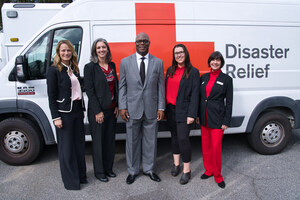CLEVELAND, June 20, 2014 /PRNewswire-USNewswire/ -- The American Red Cross is continuing a transformation of its operations to help people in need in a more efficient way that makes the best use of donor dollars, Gail McGovern, president and CEO of the American Red Cross, told the City Club of Cleveland today.
McGovern, who joined the Red Cross six years ago in June 2008, has led the organization's response to major disasters such as the Superstorm Sandy, the Haiti earthquake and the Oklahoma tornadoes. In addition, the 133-year-old Red Cross has been making changes to be better able to fulfill its humanitarian mission today and tomorrow.
The Red Cross had a $209 million operating deficit when McGovern arrived in 2008, and the operating deficit was eliminated within two years by streamlining operations, eliminating duplication of some activities, and making tough decisions in the face of economic challenges.
As a result of these changes, the Red Cross has broken even or finished with a modest surplus in three of the past four fiscal years and is paying down its debt. McGovern credited the financial turnaround and changes to the dedication of Red Cross donors, volunteers and employees.
"Their hard work, sense of teamwork and commitment to our mission literally saved the Red Cross," she said.
McGovern said the Red Cross is committed to being a healthy, vibrant and sustainable organization now and in the years ahead. The need to improve is constant.
"Now we're facing a new set of financial challenges that are forcing us to re-engineer other parts of our operation," McGovern said, referring to it as "Turnaround 2, the sequel."
The Red Cross is focused on a long-term plan that will put an even greater focus on engaging volunteers, continue to lower costs and allow the Red Cross to become even more efficient in delivering all of its programs.
McGovern said an overall drop in demand for blood products poses a new set of financial challenges for the Red Cross. The decline in demand, caused by more advanced medical treatments and improved blood management by hospitals, impacts the entire blood services industry.
In response to these changing market conditions, the Red Cross is relooking at its blood operations to adjust capacity to the new level of demand, improve services to all customers, streamline processes and increase productivity.
McGovern also described the past busy 18 months for the Red Cross because of the large number of big disasters. She noted that in April 2013, the Red Cross responded to the terrible tragedy that occurred at the Boston Marathon and the explosion of a fertilizer plant a few days later in the small town of West, Texas. Then in May, devastating tornadoes hit Oklahoma and Texas, followed by wildfires in many areas of the West. Meanwhile, the Red Cross continues to help people affected by Superstorm Sandy nearly 20 months after that storm caused severe damage in New York and New Jersey. Last month, McGovern was in Arkansas with Jeh Johnson, the new Secretary of Homeland Security, and former President Clinton after deadly tornadoes swept through several states in the South.
Internationally, the Red Cross is playing an active role in the ongoing relief and recovery work in the Philippines in the wake of Typhoon Haiyan last November, and continues its work in Haiti after the 2010 earthquake there.
McGovern noted that these large disasters are only part of the nearly 70,000 disasters that the Red Cross responds to each year, a number that includes tens of thousands of single family house fires, local floods, and water main breaks that never make the evening news or local newspaper.
"These seemingly 'small' disasters are of epic proportions for families that are impacted by one," McGovern said, "and the Red Cross must be there to provide food, shelter and care."
Over the past year in Northeast Ohio, the Red Cross assisted more than 3,900 individuals and families impacted by disaster. In addition, the Red Cross produced nearly 264,000 blood products for 57 hospitals in the region.
The Red Cross also provides lifesaving training to millions of people each year, has issued a series of free apps on First Aid and different disasters, responds to international disasters, supports work such as measles vaccinations in countries around the world, and helps members of the military and their families before, during and after deployments.
About the American Red Cross:
The American Red Cross shelters, feeds and provides emotional support to victims of disasters; supplies about 40 percent of the nation's blood; teaches skills that save lives; provides international humanitarian aid; and supports military members and their families. The Red Cross is a not-for-profit organization that depends on volunteers and the generosity of the American public to perform its mission. For more information, please visit redcross.org or visit us on Twitter at @RedCross.
Logo - http://photos.prnewswire.com/prnh/20090108/RedCrossLOGO
SOURCE American Red Cross
WANT YOUR COMPANY'S NEWS FEATURED ON PRNEWSWIRE.COM?
Newsrooms &
Influencers
Digital Media
Outlets
Journalists
Opted In



Share this article